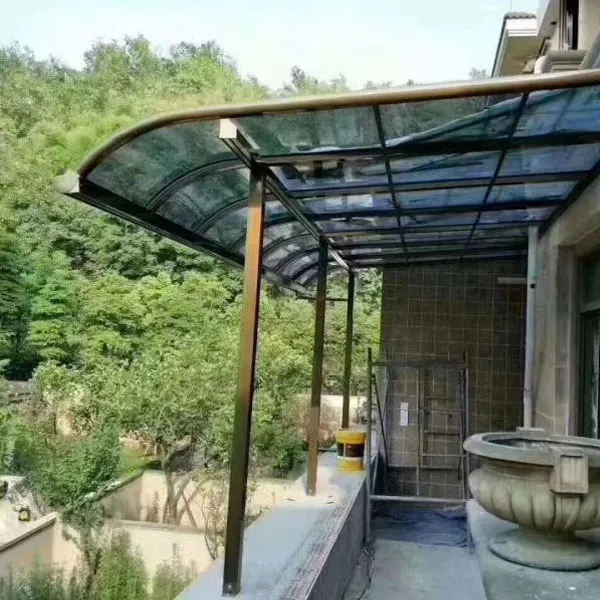A Guide to Awnings: Enhancing Outdoor Living Spaces
2024-10-23
An awning is a simple yet versatile addition to any home or commercial space that not only enhances the aesthetic appeal but also provides functional benefits such as protection from the elements. Whether you’re looking to create a shaded area for relaxation or improve the energy efficiency of your home, an awning can be a valuable investment.
In this blog, we'll explore the various types of awnings, their benefits, and how they can transform outdoor living spaces into comfortable, inviting areas.
What is an Awning?
An awning is a secondary covering that is attached to the exterior of a building, typically over windows, doors, patios, or decks. It can be made from materials like fabric, metal, or polycarbonate, and is supported by a frame that is mounted to the building.
Awnings can be either fixed (stationary) or retractable, allowing users to extend or retract the covering based on weather conditions or personal preference. Awnings serve a range of functions, from providing shade to enhancing curb appeal.
Benefits of Awnings
Awnings are more than just decorative additions to a home or business; they offer practical benefits that make outdoor living more enjoyable and functional.
1. Sun Protection
One of the primary functions of an awning is to provide shade and protect outdoor spaces from the sun’s harmful UV rays. Whether you’re relaxing on your deck or entertaining guests on the patio, an awning helps create a cooler, more comfortable environment.
Awnings also protect interior spaces by blocking direct sunlight from entering through windows, which helps reduce glare and prevents fading of furniture, carpets, and artwork.
2. Energy Efficiency
By shading windows and doors from the sun, awnings can significantly reduce indoor temperatures. This natural cooling effect helps lower the demand for air conditioning during hot months, leading to energy savings. According to studies, awnings can reduce cooling energy usage by up to 25%, making them an eco-friendly addition to any home.
3. Weather Protection
In addition to protecting from the sun, awnings also provide shelter from light rain. Retractable awnings can be extended during unexpected showers, allowing outdoor activities to continue uninterrupted. They also help protect outdoor furniture and décor from rain damage, extending the life of your belongings.
4. Enhanced Curb Appeal
Awnings come in various styles, materials, and colors, allowing homeowners to personalize the exterior of their homes. Whether you prefer a modern, sleek design or a more classic, traditional look, an awning can enhance the visual appeal of your property, making it stand out.
5. Extended Outdoor Living Space
For homes with limited indoor space, an awning can help create an extended living area outdoors. With a covered patio or deck, homeowners can enjoy outdoor activities like dining, reading, or entertaining in comfort, regardless of the weather.
6. Privacy
Awnings, particularly when installed on balconies or patios, provide a degree of privacy from neighbors or passersby. By covering outdoor spaces, awnings can create a more secluded area where you can relax without being in full view.
Types of Awnings

There are several types of awnings available, each suited for different applications and preferences. Here are the most common types:
1. Retractable Awnings
Retractable awnings offer the flexibility to extend or retract the covering as needed. These are popular for patios, decks, and windows because they allow homeowners to control the amount of sunlight or shade. They can be operated manually or with a motorized system, and some even come with sensors that automatically retract in strong winds or extend during sunny conditions.
Benefits:
- Adjustable shade and protection
- Can be retracted to prevent damage in bad weather
- Ideal for areas with varying weather conditions
2. Fixed (Stationary) Awnings
Fixed awnings are permanent structures that provide constant protection from the sun and rain. They are typically used over windows, doors, or entrances. Since they are stationary, they require less maintenance and can be built with more durable materials like aluminum or steel for long-term use.
Benefits:
- Durable and long-lasting
- Provides continuous shade and weather protection
- Available in various materials and styles
3. Freestanding Awnings
Freestanding awnings are not attached to a building but stand on their own, usually with support poles. These are ideal for creating shaded areas in gardens, near pools, or outdoor dining areas where there may not be a wall to attach an awning.
Benefits:
- Can be placed anywhere outdoors
- Provides flexibility for different uses
- Offers large shaded areas
4. Motorized Awnings
Motorized awnings take the convenience of retractable awnings a step further by allowing users to extend or retract them with the press of a button. Some models come equipped with sensors that automatically adjust the awning based on weather conditions, making them a smart and hassle-free solution.
Benefits:
- Easy to operate
- Can include automatic weather sensors
- Perfect for larger awnings that would be difficult to extend manually
5. Portable Awnings
Portable awnings are lightweight, movable structures that can be used for temporary shade at events, picnics, or camping. They are typically made of fabric with a collapsible frame and are easy to set up and transport.
Benefits:
- Affordable and easy to set up
- Ideal for temporary shade
- Great for outdoor events and travel
Choosing the Right Awning for Your Space
When selecting an awning for your home or business, there are several factors to consider to ensure you choose the right type for your needs.
1. Location: Where do you plan to install the awning? A retractable awning may be ideal for a patio or deck, while a fixed awning might be better for window and door applications.
2. Material: The material of the awning plays a significant role in its durability and appearance. Fabric awnings, often made of acrylic or polyester, provide a wide range of colors and designs but may require more maintenance. Metal and polycarbonate awnings offer greater durability and weather resistance.
3. Climate: Consider the weather conditions in your area. If you live in a region with high winds or heavy rain, a fixed or motorized awning with wind sensors may be the best choice. In areas with strong sun exposure, UV-resistant materials are essential.
4. Budget: Awnings come in a range of prices, depending on their size, material, and features. Retractable and motorized awnings tend to be more expensive than fixed or portable options, but the convenience and flexibility they offer may justify the cost.
5. Style: Don’t forget to consider the aesthetics of the awning. Choose a design, color, and material that complements the architecture and exterior décor of your home or business.
Conclusion
An awning is a smart, practical, and stylish addition to any outdoor space. It enhances comfort by providing shade, reducing heat, and offering protection from the elements while also improving the overall look of your property. Whether you’re looking for a retractable awning for your deck or a fixed awning to protect your windows, the right awning can make a world of difference in how you enjoy and use your outdoor areas.
By choosing the right type and material, an awning can be a long-term investment that adds value to your home, boosts energy efficiency, and expands your living space.


